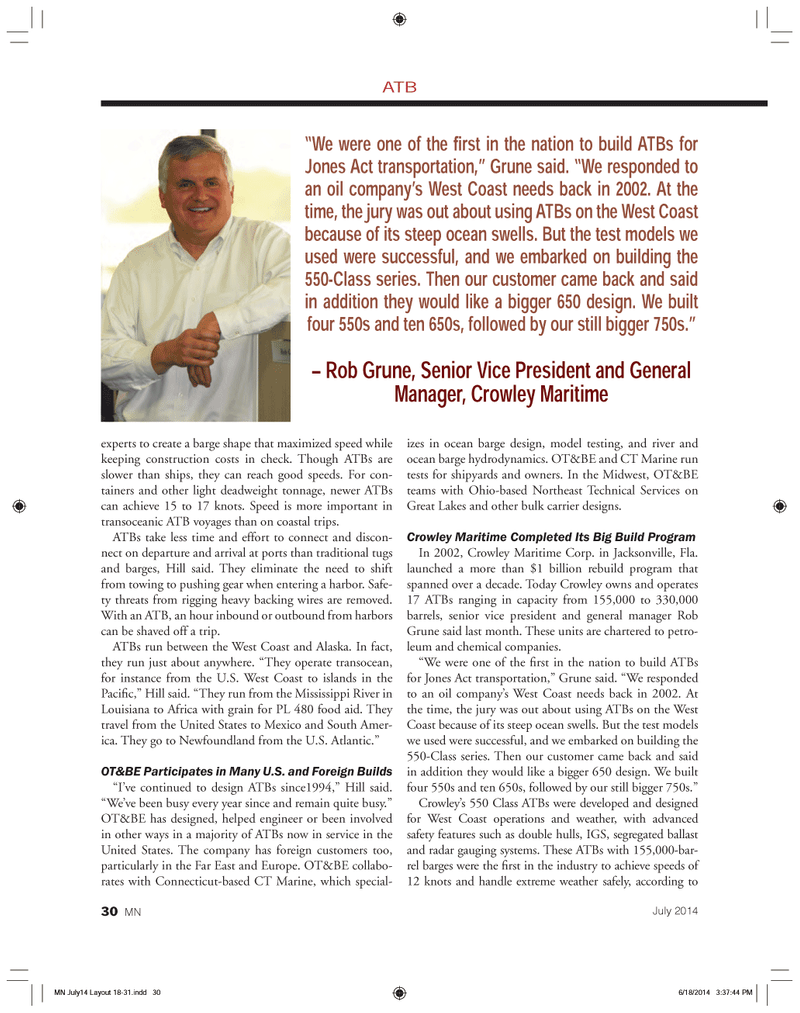
Page 30: of Marine News Magazine (July 2014)
ATB Technical Trends
Read this page in Pdf, Flash or Html5 edition of July 2014 Marine News Magazine
ATB experts to create a barge shape that maximized speed while keeping construction costs in check. Though ATBs are slower than ships, they can reach good speeds. For con- tainers and other light deadweight tonnage, newer ATBs can achieve 15 to 17 knots. Speed is more important in transoceanic ATB voyages than on coastal trips. ATBs take less time and effort to connect and discon- nect on departure and arrival at ports than traditional tugs and barges, Hill said. They eliminate the need to shift from towing to pushing gear when entering a harbor. Safe- ty threats from rigging heavy backing wires are removed. With an ATB, an hour inbound or outbound from harbors can be shaved off a trip. ATBs run between the West Coast and Alaska. In fact, they run just about anywhere. ?They operate transocean, for instance from the U.S. West Coast to islands in the Paci c,? Hill said. ?They run from the Mississippi River in Louisiana to Africa with grain for PL 480 food aid. They travel from the United States to Mexico and South Amer- ica. They go to Newfoundland from the U.S. Atlantic.? OT&BE Participates in Many U.S. and Foreign Builds ?I?ve continued to design ATBs since1994,? Hill said. ?We?ve been busy every year since and remain quite busy.? OT&BE has designed, helped engineer or been involved in other ways in a majority of ATBs now in service in the United States. The company has foreign customers too, particularly in the Far East and Europe. OT&BE collabo- rates with Connecticut-based CT Marine, which special- izes in ocean barge design, model testing, and river and ocean barge hydrodynamics. OT&BE and CT Marine run tests for shipyards and owners. In the Midwest, OT&BE teams with Ohio-based Northeast Technical Services on Great Lakes and other bulk carrier designs. Crowley Maritime Completed Its Big Build Program In 2002, Crowley Maritime Corp. in Jacksonville, Fla. launched a more than $1 billion rebuild program that spanned over a decade. Today Crowley owns and operates 17 ATBs ranging in capacity from 155,000 to 330,000 barrels, senior vice president and general manager Rob Grune said last month. These units are chartered to petro- leum and chemical companies. ?We were one of the rst in the nation to build ATBs for Jones Act transportation,? Grune said. ?We responded to an oil company?s West Coast needs back in 2002. At the time, the jury was out about using ATBs on the West Coast because of its steep ocean swells. But the test models we used were successful, and we embarked on building the 550-Class series. Then our customer came back and said in addition they would like a bigger 650 design. We built four 550s and ten 650s, followed by our still bigger 750s.? Crowley?s 550 Class ATBs were developed and designed for West Coast operations and weather, with advanced safety features such as double hulls, IGS, segregated ballast and radar gauging systems. These ATBs with 155,000-bar- rel barges were the rst in the industry to achieve speeds of 12 knots and handle extreme weather safely, according to ?We were one of the Þ rst in the nation to build ATBs for Jones Act transportation,? Grune said. ?We responded to an oil company?s West Coast needs back in 2002. At the time, the jury was out about using ATBs on the West Coast because of its steep ocean swells. But the test models we used were successful, and we embarked on building the 550-Class series. Then our customer came back and said in addition they would like a bigger 650 design. We built four 550s and ten 650s, followed by our still bigger 750s.? ? Rob Grune, Senior Vice President and General Manager, Crowley Maritime July 201430 MNMN July14 Layout 18-31.indd 30MN July14 Layout 18-31.indd 306/18/2014 3:37:44 PM6/18/2014 3:37:44 PM

 29
29

 31
31
